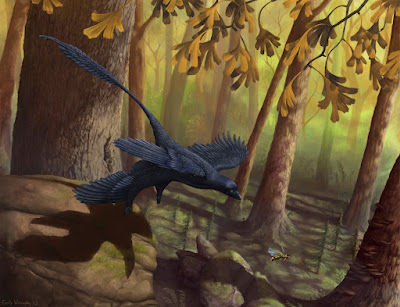I've actually had a few people recently comment on my accurate cast shadows in my artwork, so I thought I'd share a little secret.
I have some difficulty composing accurate cast shadows in my head, though I've gotten much, much better at it over the years, thanks in large part to Jon who has been tirelessly critiquing my shading since 2006. He has an almost uncanny ability to rotate three-dimensional objects in his head, an ability that I don't have to quite that degree. However, I have more recently acquired an additional skill in my toolbox for shading, something I learned from the great James Gurney.
Recently I set out to reconstruct a four-and-a-half-year-old picture of mine that had fallen far out of date both in terms of accuracy and artistic proficiency:
This picture was drawn for a publication that, then in its infancy, is now finally bordering on the cusp of maturation, but after the Microraptor color study I knew I had to redo this one to bring it up-to-date. I wanted the composition to remain nearly the same, but the animal itself needed a makeover, and this included the cast shadow.
Lo and behold - I'm actually not terrible at sculpting. Who knew?
Of course, this sculpt involved just the barest of details, and will probably never be "completed" in the sense of being a finished sculpture, but I did my best to make it anatomically accurate and it certainly served its intended purpose. The basic lateral anatomy is based on the original drawing in Xu Xing 2003:
And then beefed up with what I know of dromaeosaurid and bird anatomy with a very lightweight type of modeling clay.
Using the guideline of the model, I could then create the finished image with cast shadows intact.
Obviously this sort of process is far too time-consuming to use on everything I draw, but it's kind of fun for more important paintings that need to be as accurate and consistent as possible.




